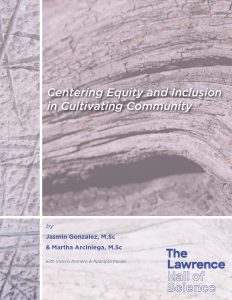Historically, Black, Indigenous, and people of color (BIPOC) have been systematically excluded from outdoor spaces and recreational activities. For example, it wasn’t until the 1964 Civil Rights Act that Black communities could legally use public spaces, which included National and State Parks (Humphrey, 2020). Although there have been efforts to create more inclusive outdoor recreational spaces, BIPOC continue to experience discrimination, and some have lost their lives. Two recent examples include Christian Cooper, a Black birder who had the cops called on him by a white woman while bird watching (CBS News, 2020) and Ahmaud Arbery, a Black man who was killed while exercising outdoors (Sanchez, 2020). Further, when we look within the field of environmental science and education, we continue to see the disproportional underrepresentation of BIPOC in career pathways and positions of leadership (Taylor, 2014).
To counteract such exclusion, many outdoor science organizations have implemented different strategies. They have strived to create opportunities for meaningful experiences in natural settings for students from diverse communities. Outdoor science organizations have also made efforts to interview and hire more diverse field staff. Field staff play a significant role because they connect with students on the ground and find ways to make the experience transformational, unique, and relevant to students’ daily lives. Yet, staff diversity alone cannot result in equity and inclusion in environmental education. Equity, Inclusivity, and Diversity (EI&D) training add to efforts to counteract exclusion to outdoor recreational spaces and careers. However, EI&D work within environmental education organizations has historically been led by and centered around white people (Romero et al., 2019); subsequently this has de-centered BIPOC staff perspectives and needs.
We represent staff of color working in the environmental education field. The perspectives of this brief and the values outlined for creating a community that centers equity and inclusion are shaped by the Working Towards Equitable Organizations (WTEO) project. Drawing on our first-hand experiences, the goal of this brief is to bring awareness to the ways that white supremacy culture has shown up in the field of environmental education. We also share ways in which we believe organizations can counteract those experiences as a means towards cultivating more equitable, inclusive, and racially just organizations. However, this is not a comprehensive manual on how to center equity and inclusion, rather a call for environmental organizations to carefully consider how they are centering BIPOC staff in goals/priorities, decision-making, and providing a space of healing.
ACKNOWLEDGMENTS
This brief is the fourth in our series resulting from a collaborative project, Working Towards Equitable Organizations, funded by the Pisces Foundation and the Clarence E. Heller Charitable Foundation, and would not be possible without all of the partners: Charity Maybury, Christy Rocca, and Francis Taroc of Crissy Field Center at the Golden Gate National Parks Conservancy; José González, founder of Latino Outdoors; Eric Aaholm of YES Nature to Neighborhoods; and Kim Moore Bailey, Laura Rodriguez, and Rena Payan of Justice Outside (formerly Youth Outside).
Our first brief, Examining Equitable and Inclusive Organizations in Environmental Education: Perspectives from the Field (Romero, Foreman, Strang, Rodriguez, Payan, & Moore Bailey 2019), drew our attention to an important consideration: that “many equity, inclusion, and diversity initiatives are primarily focused on external-facing programs; that is, organizations are more likely to be thinking about equity, inclusion, and diversity in regard to learning experiences for learners, as opposed to the organizational work environment” (p. 3). The lack of focus on the organizational work environment marginalizes people of color in the field.
The second brief in this series, Intentional Hiring and Recruitment through the Lens of Equity and Inclusion: Insights and Lessons Learned from Crissy Field Center, Golden Gate National Parks Conservancy (Romero, Foreman, Strang, Maybury, Pepito, & Rocca 2019), highlighted the organizational journey toward mitigating unconscious bias in their recruitment and hiring practices, as a means towards cultivating a workforce that reflects the youth they serve and their organization-wide core values of equity and inclusion.
The third brief in this series, Building Towards an Inclusive Organizational Culture: Insights and Lessons Learned from YES Nature to Neighborhoods (Hernández, Romero, Foreman & Aaholm 2020), highlighted the organizational journey toward building an inclusive organizational culture, as a means towards advancing equity and inclusion within the work environment and enabling the organization to better engage participants and partners.
This fourth brief brings our work full-circle, serving to amplify the perspectives of Professionals of Color who work in outdoor science organizations. In this brief, Jasmin Gonzalez and Martha Arciniega draw on their experiences to highlight ways organizations can center equity and inclusion through cultivating community. We also thank and offer gratitude to Leandra Darden and Gina Carrillo for their review, advice and support of this brief.
Lead funding for this study was provided by the Pisces Foundation.
Additional funding was provided by the Clarence E. Heller Foundation.

